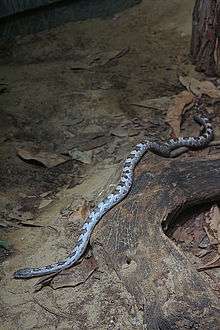Gray ratsnake
| Gray ratsnake | |
|---|---|
 | |
| Scientific classification | |
| Kingdom: | Animalia |
| Phylum: | Chordata |
| Subphylum: | Vertebrata |
| Class: | Reptilia |
| Order: | Squamata |
| Suborder: | Serpentes |
| Family: | Colubridae |
| Subfamily: | Colubrinae |
| Tribe: | Lampropeltini |
| Genus: | Pantherophis |
| Species: | P. spiloides |
| Binomial name | |
| Pantherophis spiloides (A.M.C. Duméril, Bibron, & A.H.A. Duméril, 1854) | |
| Synonyms | |
| |
The gray ratsnake or gray rat snake (Pantherophis spiloides),[1] also known as the midlands ratsnake or chicken snake, is a member of the genus Pantherophis in the subfamily Colubrinae. The gray ratsnake is one of ten species within the genus Pantherophis, which includes ratsnakes, corn snakes, and fox snakes.
Description
.jpg)
A medium to large serpent, gray rat snakes typically reach an adult size of 99–183 cm (39–72 in); however, the record is 215 cm (85 in). Unlike other Pantherophis, whose conspicuous juvenile pattern fades into adulthood, gray ratsnakes do not undergo drastic ontogenetic changes in color or markings. These snakes retain the juvenile pattern of dark elongate dorsal blotches separated by four, or more, pale gray body scales, a light gray crown with dark striping that forms an anteriorly facing spearpoint, and a solid band which covers the eyes and extends rearward to the posterior upper labial scales. The venter is usually off-white or pale gray with darker irregular blotches, and a double row of black spots behind the divided anal plate of the vent. The dorsal scale rows around midbody are usually weakly keeled. Because the gray ratsnake shares its range with other members of its genus, hybrids of midlands x eastern ratsnakes are not uncommon.
Distribution and habitat
Native to North America, the Gray Ratsnake is commonly found in the forests of eastern and central United States. It occurs relatively continuously throughout the major part of the eastern half of the United States, along the western edge of the Appalachian Mountains, from southwestern New England to the Gulf of Mexico, westward to the Mississippi River, and northward from northern Louisiana to southwestern Wisconsin.
In Canada, this species is known to occur in two disjunct regions of southern Ontario: the Carolinian forest region along the north shore of Lake Erie in the southwest, and the Great Lakes/St. Lawrence region in the southeast.[2][3]
Behavior and reproduction
An agile climber, gray ratsnakes are at home from the ground to the tree tops in many types of hardwood forest and cypress stands, along tree-lined streams and fields, and even barns and sheds in close proximity to people. Within its range, almost any environment rich in rodents, and vertical escape options, proves a suitable habitat for the gray ratsnake. As scent-hunters these powerful constrictors feed primarily on rodents, birds, and their eggs as adults, while neonates and juveniles prefer a diet of frogs and lizards. When startled, this species, like other ratsnakes, stops and remains motionless with its body held in a series of wave-like kinks. The gray ratsnake will defend itself by raising its head and bluffing a strike. If handled, these snakes will musk a victim by releasing the foul-smelling contents of their cloaca, and will bite if necessary. However, the gray ratsnake is less likely to bite than other members of its species, and wounds from a bite rarely require more than a bandage. Breeding takes place from April to July. Females deposit 5 to 27 eggs around mid-summer, and the 25–30 cm (9.8–11.8 in) hatchlings usually emerge in September.
Status
The Grey Ratsnake is considered common across much of its range, but is listed as "of special concern" in Michigan [4] and is also listed as rare in Wisconsin.[5] Grey ratsnakes are listed federally in Canada as "endangered" (Carolinean population) and "threatened" (Great Lakes/St Lawrence population).[6] In the state of Georgia, all indigenous, nonvenomous snakes are illegal to kill or capture, and are considered to be in the custody of the Georgia Department of Natural Resources.[7]
References
- ↑ Pantherophis Fitzinger, 1843—NORTH AMERICAN RATSNAKES". in Scientific and Standard English Names of Amphibians and Reptiles of North America North of Mexico, With Comments Regarding Confidence In Our Understanding. Edition 6.1 Last updated: 24 May 2011.
- ↑ Species at Risk Public Registry – Species Profile (Gray Ratsnake). Sararegistry.gc.ca. Retrieved on 2013-08-24.
- ↑ Gray Ratsnake, Ontario Nature
- ↑ Grey ratsnake, Michigan Department of Natural Resources
- ↑ Grey ratsnake, Wisconsin Department of Natural Resources
- ↑ Canada Species At Risk Act
- ↑ Georgia Wildlife.org Keeping Georgia Wildlife as Pets. georgiawildlife.org
Further reading
- Duméril A-M-C, Bibron G, Duméril A[-H-A]. 1854. Erpétologie générale ou histoire naturelle complète des reptiles. Tome septième. Première partie. Comprenant l'histoire des serpents non venimeux. Paris: Roret. xvi + 780 pp. (Elaphis spiloides, new species, pp. 269–270).
- Wright AH, Wright AA. 1957. Handbook of Snakes of the United States and Canada. Ithaca and London: Comstock. 1,105 pp. (in 2 volumes) (Elaphe obsoleta spiloides, pp. 249–253, Figure 77 + Map 24 on p. 235).
External links
| Wikimedia Commons has media related to Pantherophis spiloides. |